Painting Roses and Their Spirit
This week, we get inspiration from roses – their spirit, resilience, and decorative beauty.
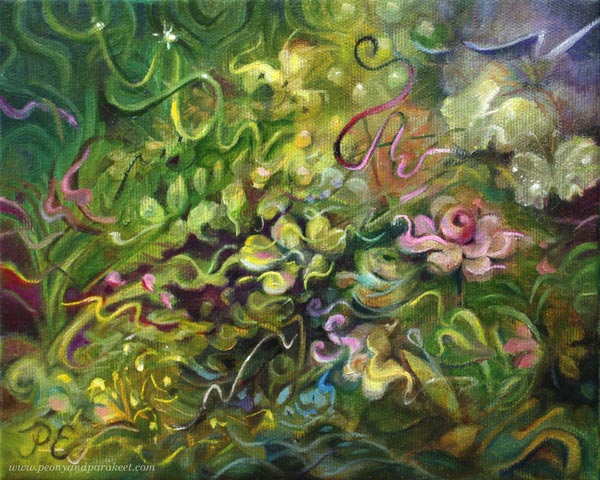
With this post, I want to encourage you to expand the use of decorative art. You can add decorative elements to any art style! See another example in the older blog post: From Decorative to Expressive Art
The Spirit of the Rose Stays Alive in The Fall
Roses surprise me every fall. When other flowers have given up weeks ago, roses still make buds and continue to bloom. Not as galore as in summer, but they try their best on cold nights and cloudy days. The spirit of the rose is born from warmth and light, but once it’s up, it doesn’t quench easily.
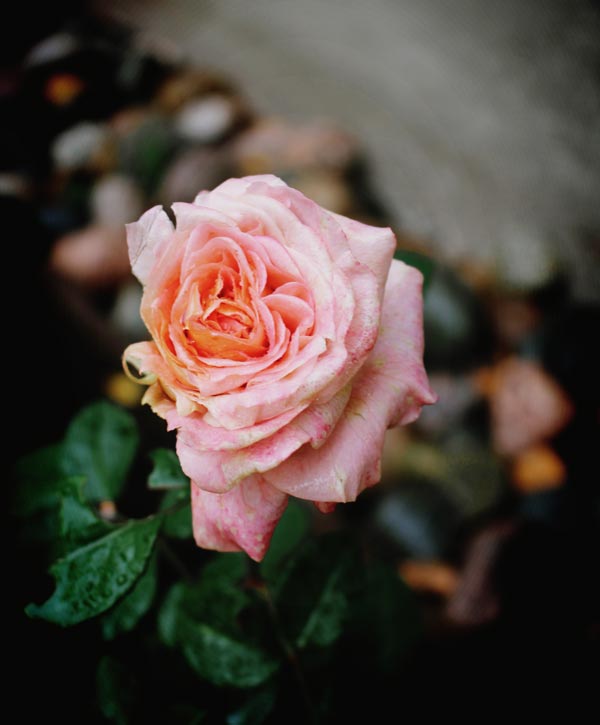
In our garden, roses are more my husband’s thing – I collect peonies! But in the fall, I have to admit how superior roses are, queens of the garden, one could say. When the colorful leaves take over the scenery, even the most modest rose flowers stand out simply because they are different in colors and shapes.
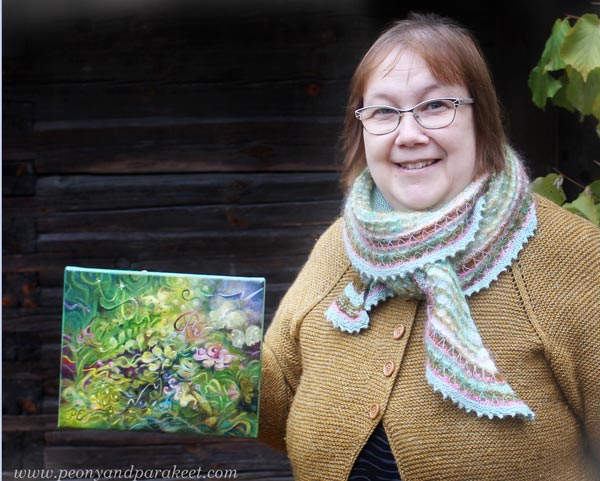
It reminds me of how resilience and beauty are connected. So mere persistence in creating makes your art beautiful.
Expressing with Small and Decorative
This painting is a small one, only 20 x 25 cm (approximately 8 x 10 inches). When I was a beginner in painting, the small size felt easier. But nowadays, I prefer big canvases, and if I want to create something small, I usually grab my colored pencils, not brushes. But on the other hand, I like the challenge that the small size gives.
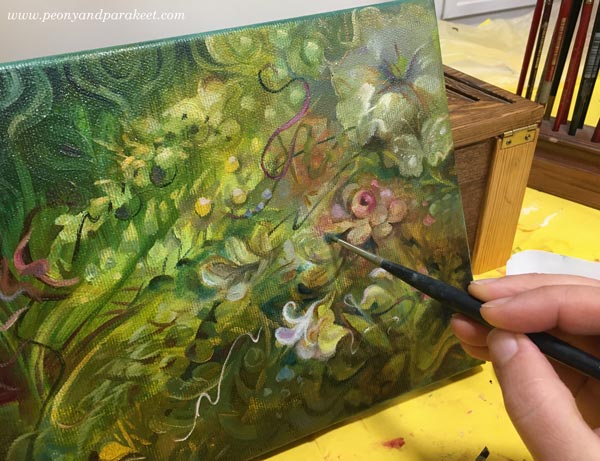
When painting roses in a small size, I need to have an extra focus on the quality of brushwork. Even the tiniest strokes should be elegant, especially if the painting is called ”The Spirit of the Rose.”
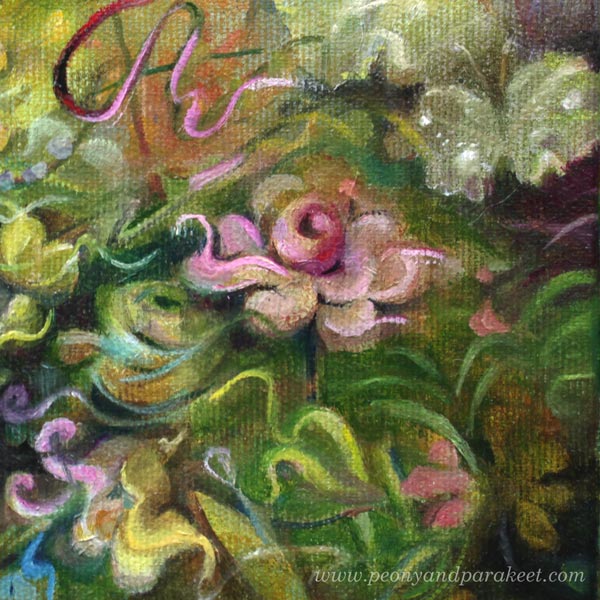
Decorative paintings often look very static, but I like to add movement with lines. At best, my small paintings are like short classical musical pieces with a clear melody, lots of short violin strokes, and clever piano tunes in major. It often helps me if I define the desired outcome by other art forms like music or movies.
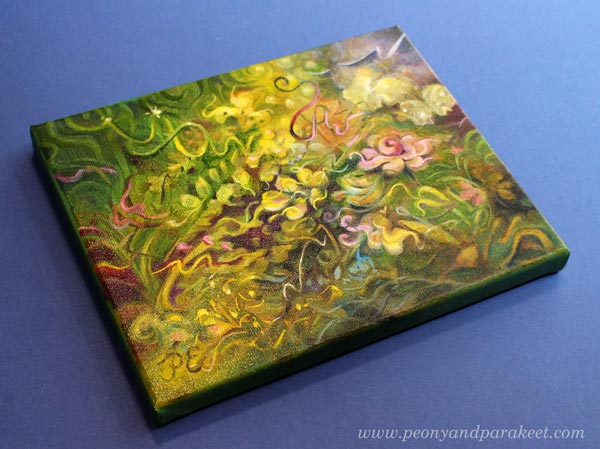
But decorative art has its limitations. The spirit of a rose is not visible if you only paint one kind of rose and if all that you paint is roses. Add flower variations, how the flowers affect their surroundings, and how the surroundings gather around the flowers. Add elements that resemble the living spirit, and let colors interact too so that the roses are not separate but part of the living scenery. So, painting roses is never just about roses, it also expresses how you see the world.
Painting Roses – Decorative Flowers of Decodashery
Even if single floral motifs are often not so expressive, I am fascinated by the techniques of decorative art, especially folk art. A couple of years ago, I noticed that I need practice with the brushstrokes. I wanted to learn to paint in a decorative style and then combine that with a looser and more abstract approach that I already had in my style toolbox. I think that style should not be a matter of narrowing down but expanding, and I felt that more experience in decorative painting was something that I could benefit from. So I made a course called Decodashery and painted flowers after flowers to improve my strokes.
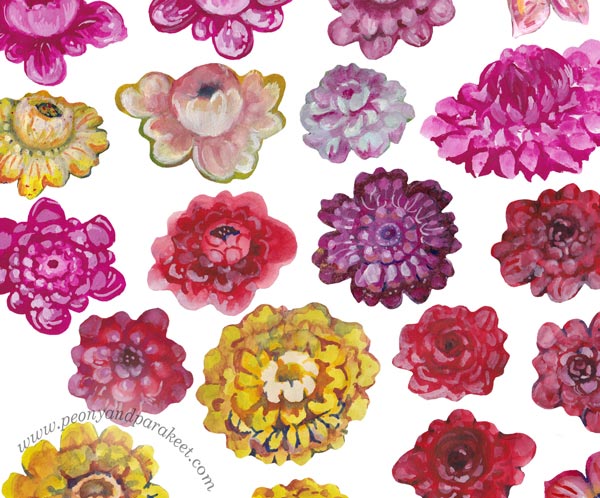
You see, preparing for the course requires deep understanding. A teacher isn’t only someone who masters the technique but one who can also break it into pieces and explain it. And by doing that, the skill becomes more stable and versatile. So, you can create quicker when knowing how things are constructed, and it’s easier to adapt the technique to your own liking. In the classes, whether you are a student or a teacher, the resilience grows, and the spirit of the rose becomes stronger: ”There’s still time to bloom, and I will do it!”
Drawing Roses and Flower Girls – New Course Is in the Making
This fall, I have not only been painting a new series but also developing a new course.
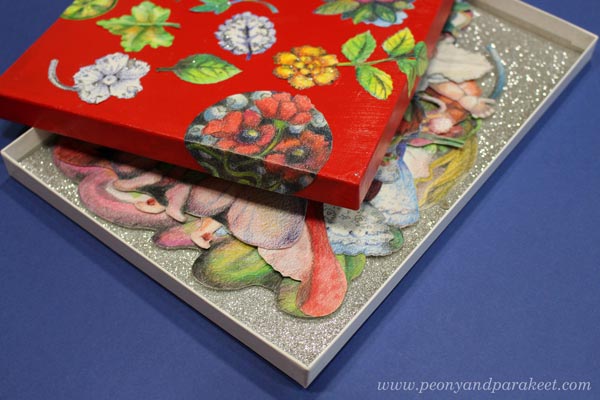
Its working title is ”Doll World,” and it’s about drawing human figures. I think it’s a skill that enables us to do illustrations that captivate the viewer and something that we all would like to do for fun too. We will draw flowers as warmups and decorate the dresses with colored pencils. I plan to run the class next year and open the registration next month. So stay tuned!
Painting Moss and Coloring Green
This week is dedicated to moss and all the shades of green!
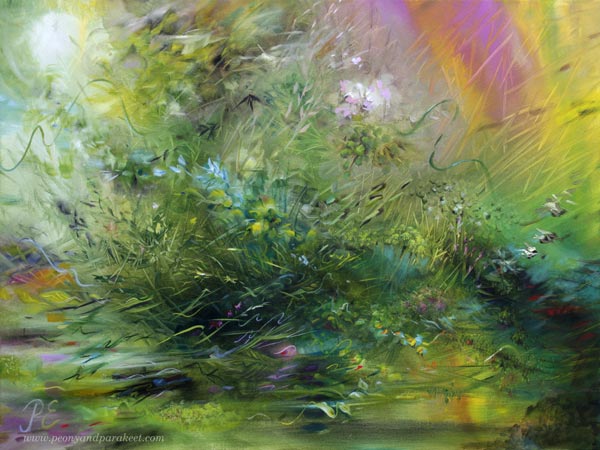
Inspired by Moss
For some gardens, moss is a bad thing, but my husband and I always get delighted when we see moss appearing. It’s like velvet, an ancient treasure, woven hundreds of years ago and still vivid and strong.
Last month, I read Elizabeth Gilbert’s book called The Signature of All Things. The protagonist Alma was a moss researcher and the space where she worked and stored her samples felt inspiring because it seemed to be a world of its own. The Finnish title for the book is Tämä kokonainen maailmani – “this whole world of mine,” and I think it describes both the book and moss brilliantly.
Making of The Echo of Moss
In this painting “The Echo of Moss,” I have wanted to express the two sides of moss – how it enables life but also gently connects us with death. Watch the video to see how it progressed step by step!
I painted this piece in oils in two separate sessions. There was a week of drying time between them. I am not always that quick, but this time I was in the flow state before making the first stroke. Probably because the subject felt both inspiring and familiar, and I love the color green.
Painting and Coloring Moss
Moss is not difficult to paint or draw. You only need softly colored variegated green in the background and then randomly placed dots or short lines on the top. Here’s an example in watercolor.
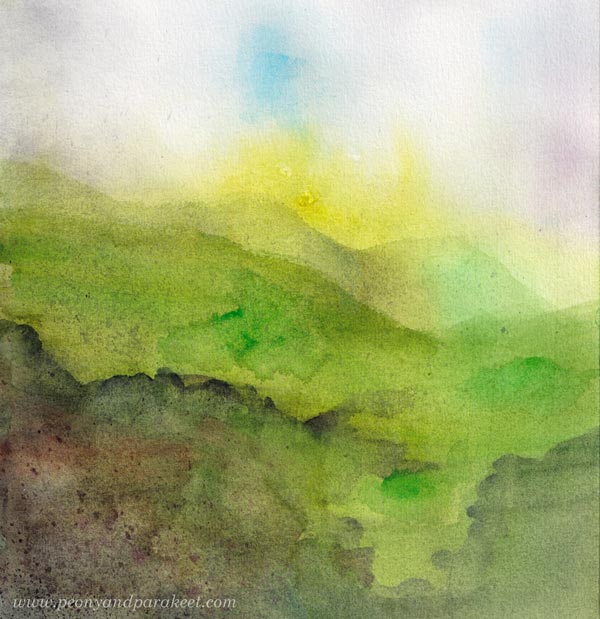
This piece is a sample from my watercolor class Magical Forest which has a lesson on painting moss.
When working with colored pencils, color a variety of greens in different directions so that single strokes are not visible. You can use browns, blacks, yellows, and blues in layers to get a wide range of warm green shades. No outlines are needed.
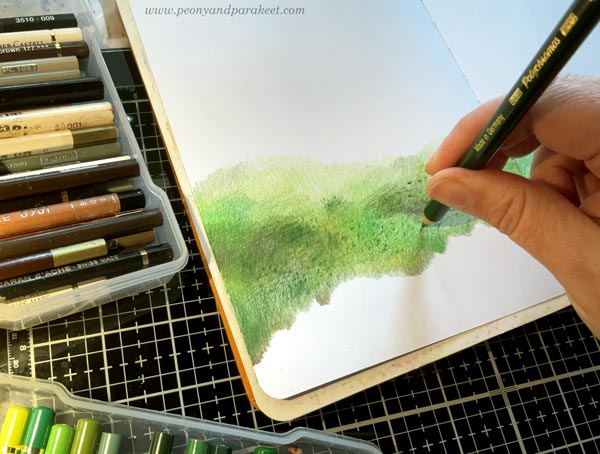
To get natural-looking spotting, close your eyes and tap your pencil randomly on the paper.
Green Green Green!
Green is my favorite color nowadays. “Every painting can’t be green, Paivi, we want variety,” I said to myself before I started painting this one. I was just like my mother who used to give permission and then remind me that it can’t be expected to happen regularly. “Yes, mother, but I want to be a goddess of green!”
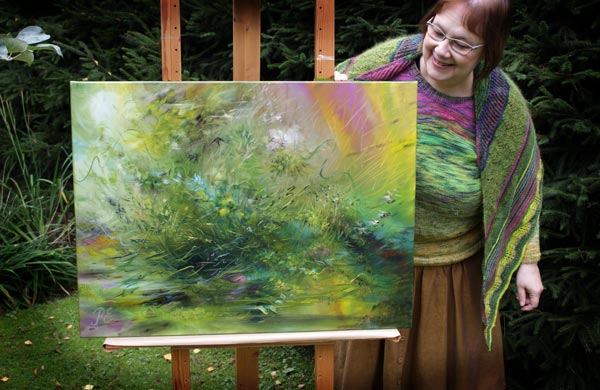
“Everything is green,” said my husband when I asked him to take this photo.
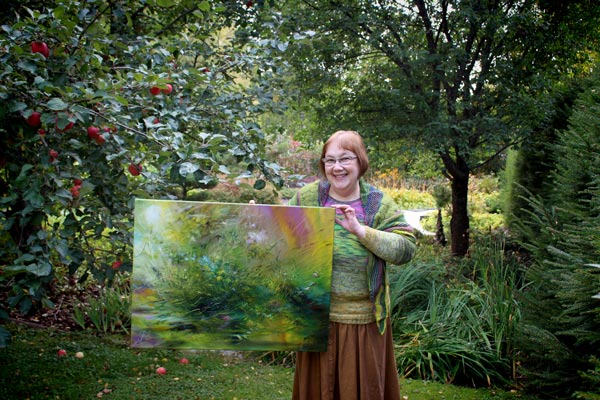
“It’s intentional!” I said to him.
I hope that this post inspires you to explore moss and different shades of green!
P.S. Speaking of color, one of my classes, Planet Color, is retiring on Sept 30.

If you are a beginner in painting and want to use acrylic paints more, for example, in your art journals, check this class! Planet Color is now more than 50% OFF before it goes away! >> Buy here!
How Your Personal Story is Related to Your Art
This week, I share how my newest painting was born. At the same time, I talk about how the artist’s personal story affects the outcome.
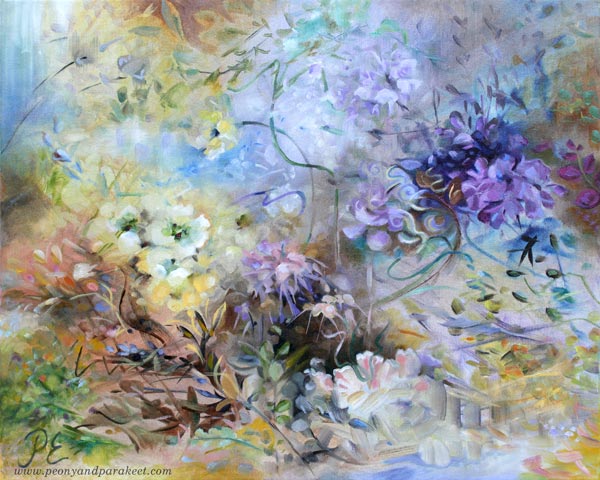
My paintings usually reflect the current season. But now, when there’s a fall in Finland, something springy appeared on my canvas. I call this one “The Spring of Dreams.”
Observing a Flower – Engineer’s and Romantic’s Approaches
Last spring was beautiful. The apple and cherry trees were blossoming.
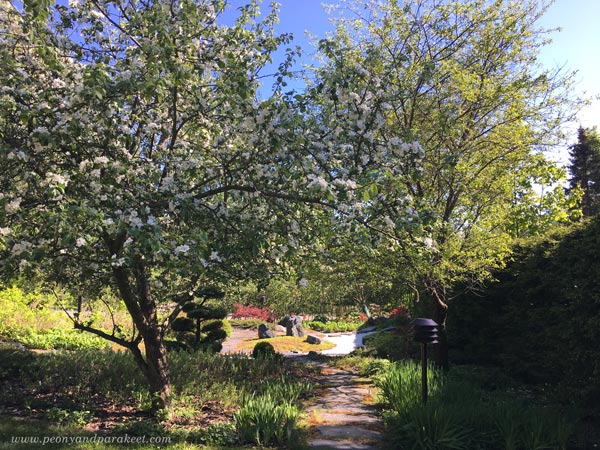
And with the early summer came wonderful irises.
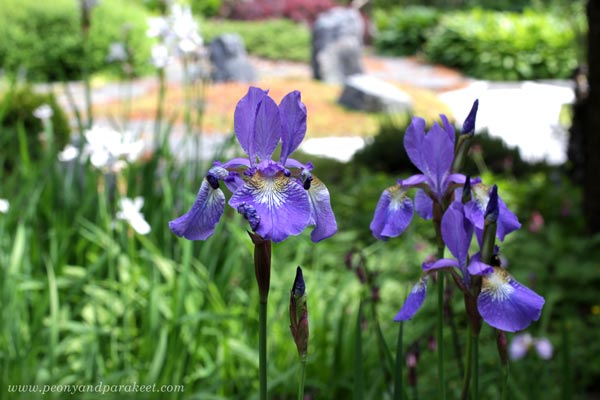
I often take photos in the garden and examine the plants. As a former engineer, I try to see how they are constructed. Not how the petals are attached and such, but how the light constructs the flower, adding its own brushmark to it. As a romantic, I try to see a face of a flower. I look at it like it would be an animal or a human – like it has a name and a history. I am not searching for its eyes but trying to sense its needs and dreams.
This way, I don’t need to copy photos but can paint freely and intuitively. Then when random shapes begin to look like a lighted plant, I try to give it what it wants, even if it’s often a species that doesn’t even exist.
The Fight Between Too Stiff and Too Messy
However, the painting process is not always as straightforward as it sounds. Often the engineer adds something stiff, and the romantic wipes it off. Then the romantic makes a mess, and the engineer tries to clean it.
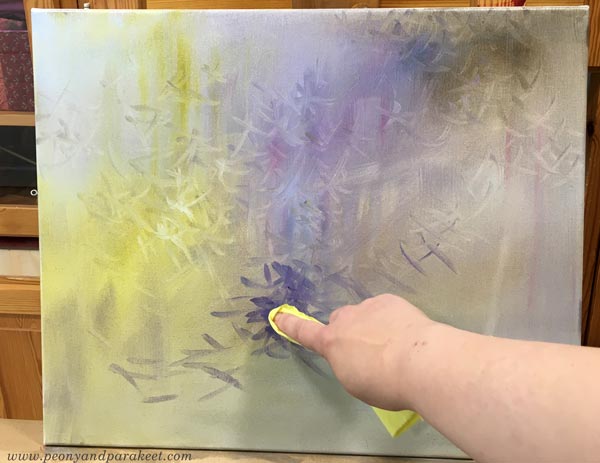
The engineer in me likes to build things with a brush: “There’s a chair, look!”
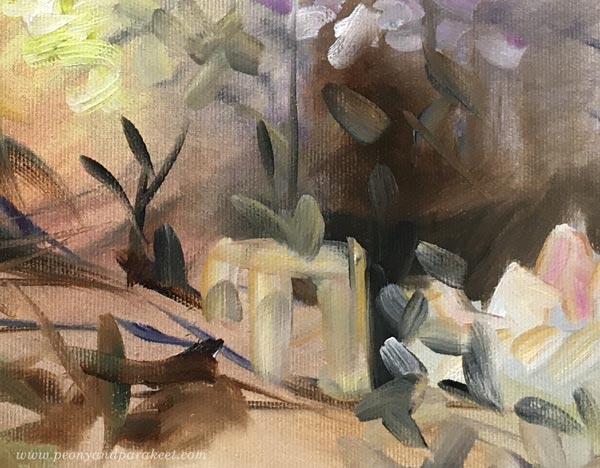
The romantic in me likes leaves and swirls more.
Artistic Direction and Setting Guidelines
To stop the fights, I gave an artistic direction that set challenges for both of them: “We will be making a dreamy floral that has purple. The painting should fit a modern, feminine home that has some rustic elements as well.” Both the engineer and the romantic understand had a common understanding of style when picturing a space where the painting should fit. When I use this method, I choose a location in my home or a picture in an interior design book, or a photo found on Instagram.
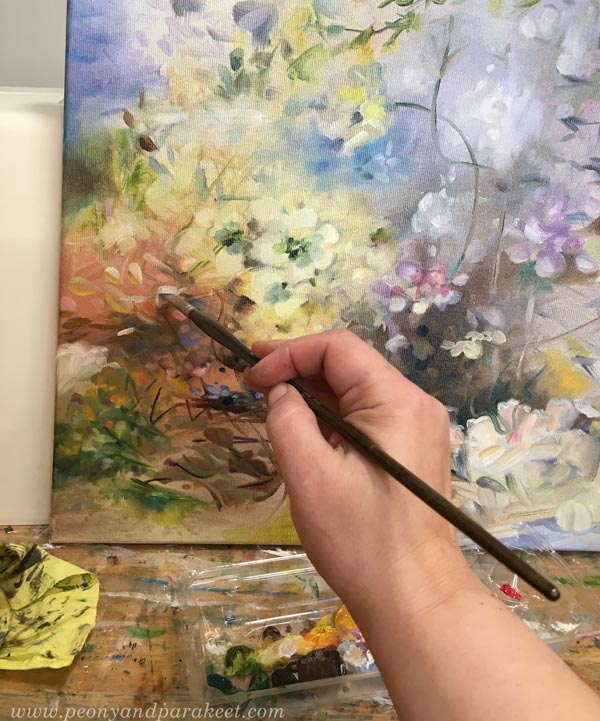
When I was studying industrial design, these kinds of simple and concrete guidelines were called design drivers. Design drivers are different from design principles. Design principles are general guidelines to make your image more expressive and aesthetic. Design drivers are project-based and loosely define the outcome.
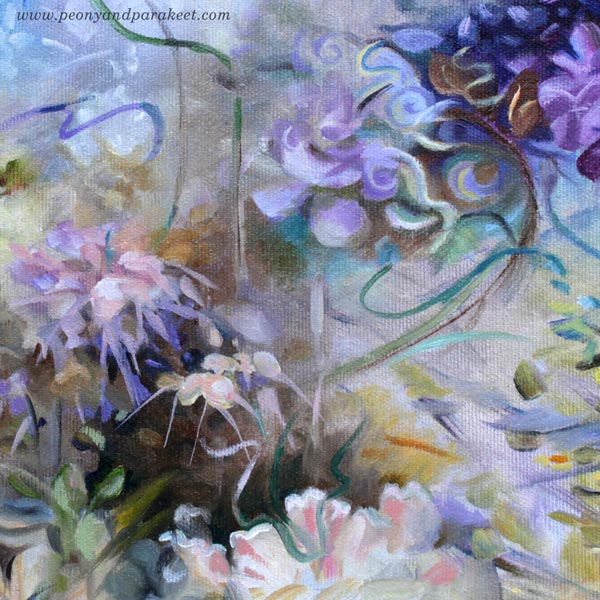
Design drivers prevent me from painting this and that, but I try to make them so general that I can get creative and freely express myself. For example, the requirement to use purple in a painting is not a big limitation.
Personal Story and Art Projects
Behind design drivers, there’s a more general foundation, an artistic vision. My paintings always lean toward the past and have a historical feel. As an artist, I want to combine the past and the present in an uplifting way, creating a fantasy of immortality for the interior space. Because I lost both of my parents at a young age, I never thought I would live old. This way, my artistic vision, and personal story are connected.

I claim that art-making has many layers. It’s not only about the process, techniques, or assignment. The artistic vision and the personal story matter as well. You always have a chance to bring them in, whether you are painting or drawing. For example, if a course sets the starting point, the creative challenge is how to include your artistic vision and story in the projects. This time, rather than listing things you love, go deeper and think about your struggles. How do they define what you want to achieve in art?
Turning Memories into Paintings
This week, I talk about memories and art-making and how the connection between them can be loose but still important.
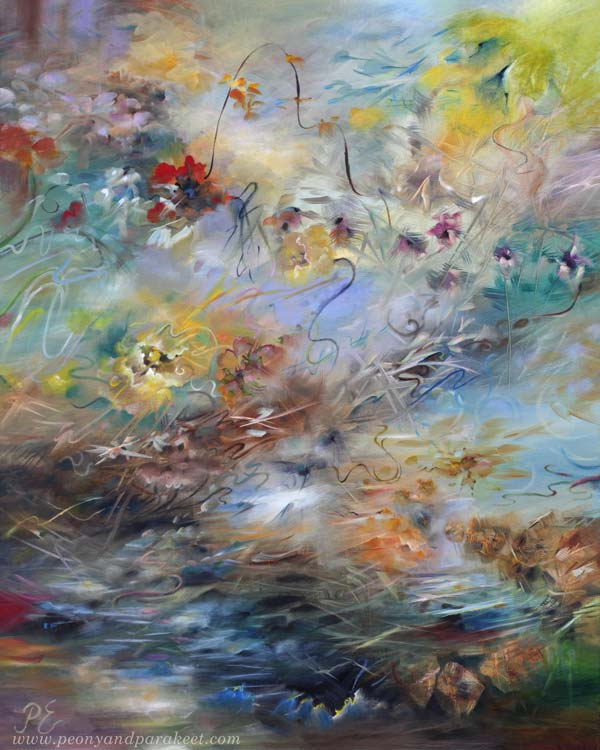
With this new painting, I want to talk about …
Books and Memories
My parents never visited another country, and as a child, I never traveled abroad. My first foreign trip was to England when I was 21 years old.
So when I think about my childhood, the first feeling that comes to mind is boredom. “Äiti, mitä mie tekisin – Mother, what could I do next?” I often asked. But my mother’s suggestions were never inspiring, and if my friends weren’t around, I usually chose to walk to the local library so that I could see the world.
My body was local, but my mind was international. Maybe it’s because our family had the book Tuhannen ja yhden yön satuja – One Thousand and One Nights, and I found it fascinatingly exotic at a very early age.
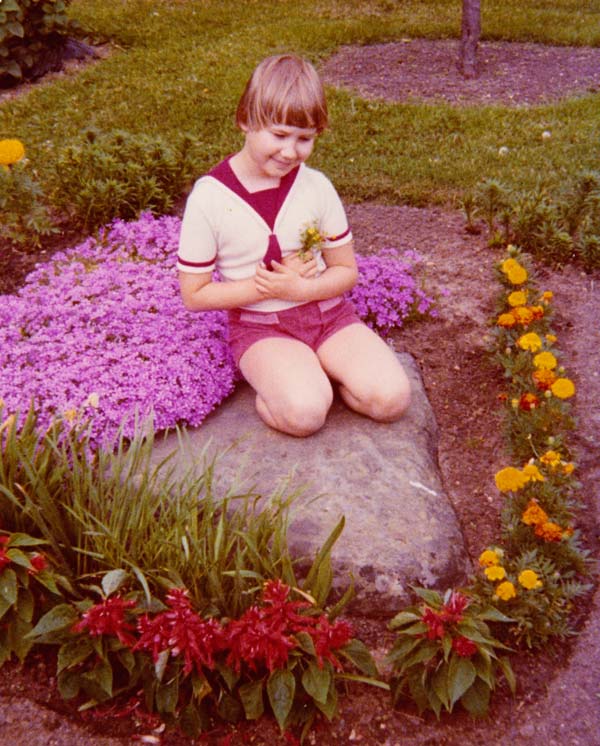
So the local library became my globe. As soon as I opened the door, I glanced at England, to the bookshelf where Jane Austen‘s novels were in a row. Then I went to Africa and Asia by browsing big encyclopedias of animals, searching for big cats. I traveled to Egypt when admiring the treasures of the pyramids. I spent hours in France and Italy, contemplating whether I liked impressionism or expressionism more. Pictures of folk dresses took me to the east, across the border. I traveled west over the sea to meet my friends Uudenkuun Emilia – Emily of the New Moon, Laura Ingalls, or Vihervaaran Anna – Anne of Green Gables. And I also spent quite a lot of time in a fictional American town through Spoonriver Anthology by Edgar Lee Masters.
When my fingers danced on the spines of the books, my mind contemplated where to go next. And always, I was able to find a place more pleasant than the small town in Eastern Finland.
Painting Freely, Inspired by Memories
This freedom of mind still inspires me. In fact, this blog is one channel to reach you who lives far away. Despite the distance, you may have read the same books, yet our memories are unique. The common stories and pictures get mixed with personal experiences and views.
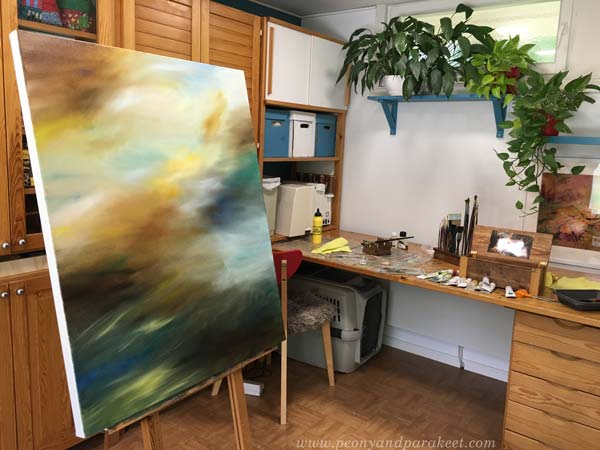
No matter how current we want to be, memories always play some role in our art too. When painting freely, it’s not as literal as illustrating a story but more about the atmosphere and associations that a traveling brush can evoke.
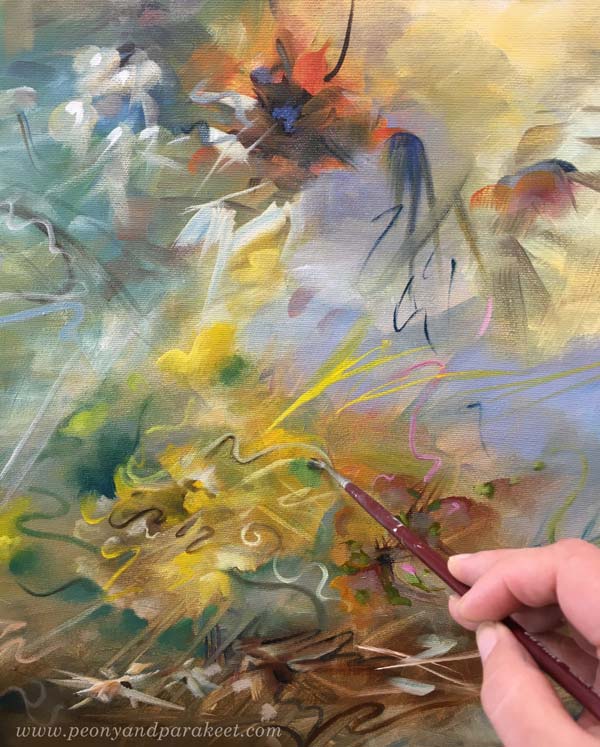
Like a child, we can get enthusiastic about very little – about a spot or a simple idea and then expand our thoughts, shapes, and colors.
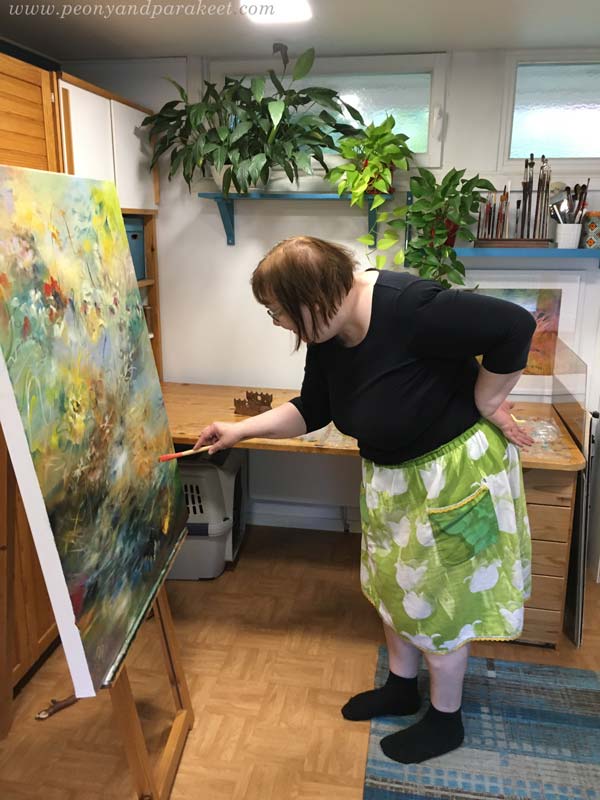
I believe that the more we paint, the more we remember who we naturally are.
My Artist’s Journey
My artist’s journey has been full of practice. A lot of it has been that I have developed a class of my recent revelations and then moved forward to find more. So, it’s been a very straightforward route that way, and I am oddly relieved that it has brought me where I am now, being able to use a brush as my pen and paint stories that go beyond words.
Right now, it doesn’t feel right to develop a new class about painting, especially when I already have the master class Floral Freedom.
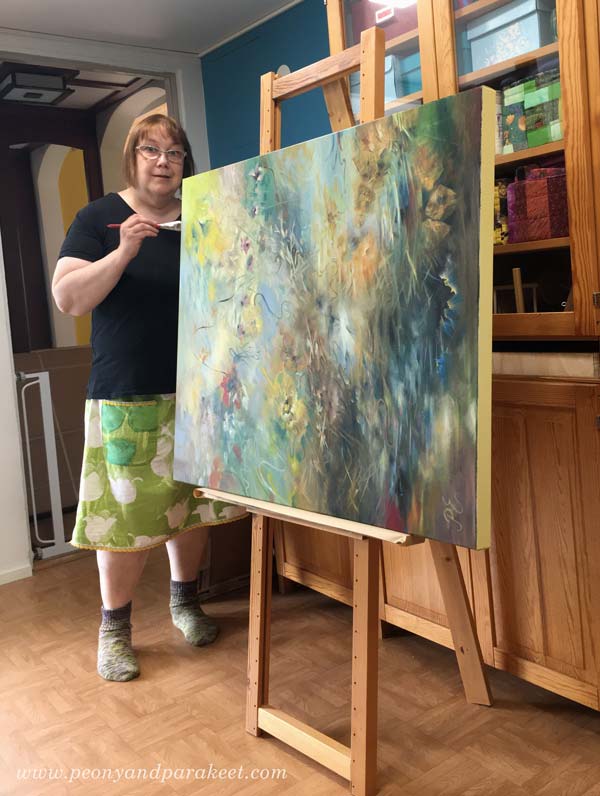
However, with the current series of paintings, I have got new ideas for drawing. A big part of my painting skills and imagination have come from drawing practices, and I love the quickness and playfulness that pens and pencils enable. So stay tuned!
Tiger’s Eye – Memories into Painting
I painted this piece, Tiikerinsilmä – Tiger’s Eye, like it would be a good book, taking me to unexpected places. Just like a child sees the world in a library, as an artist, I try to stretch my memories and imagination so that I don’t get stuck in the mundane.
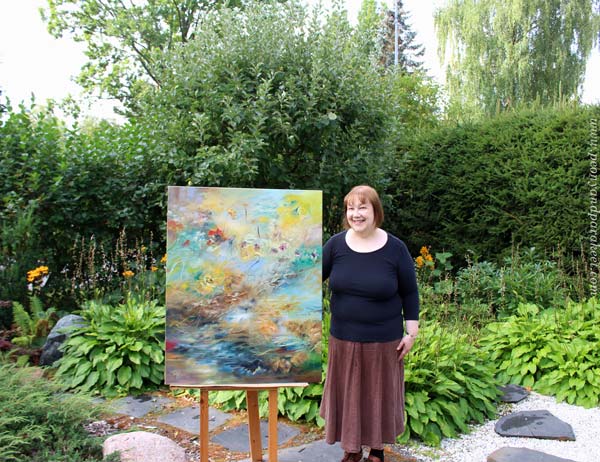
What kind of memories and hopes came to your mind when reading this post? Did you, too, read One Thousand and One Nights, for example?